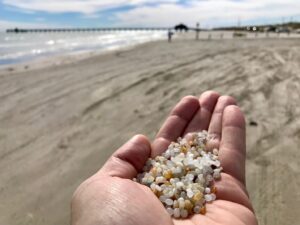The U.S. National Science Foundation National Radio Astronomy Observatory (NSF NRAO), in partnership with several leading Mexican universities and research institutes, has announced a series of landmark agreements and meetings aimed at advancing Mexico’s role in the Next Generation Very Large Array (ngVLA) project.
Recent News
Astronomers Discover a Superheated Star Factory in the Early Universe
Astronomers have uncovered a previously unknown, extreme kind of star factory by taking the temperature of a distant galaxy using the ALMA telescope. The galaxy is glowing intensely in superheated cosmic dust while forming stars 180 times faster than our own Milky Way.
Astronomers Share Largest Molecular Survey To-date: GOTHAM Legacy Data Goes Public
Astronomers in the “GBT Observations of TMC-1: Hunting Aromatic Molecules” research survey, known as GOTHAM, have released a spectral line survey with largest amount of telescope time ever conducted, charting more than 100 molecular species only found in deep space.
OCEAN Kids vs. The Nurdles

Enter caption and credit line here.
New Interactive Audio-Course on Nurdles in Development

Nurdles are small pellets used to make almost all plastic products and they are the second largest source of microplastic pollution globally.
You may have never heard of them, but they have surrounded you and your community. Nurdles are small pellets used to make almost all plastic products and they are the second largest source of microplastic pollution globally. OCEAN Kids brings together the expertise of Associated Universities Inc. (AUI), Tumble Science Podcast for Kids and the citizen science project Nurdle Patrol to create a new interactive citizen-science educational audio course on nurdles for students in grades 3-5.
“Each year an estimated 445,970 tons of nurdles wash up on beaches and riverbanks and can also be found near storm drains and freight train lines,” said Jace Tunell, founder of the Nurdle Patrol and director of community engagement at Harte Research Institute for Gulf of Mexico Studies, Texas A&M University-Corpus Christi. “We’ve been working with communities, scientists and policy makers over the last six years to locate nurdles, remove them from the environment and raise awareness of the issue. We are excited to increase awareness through OCEAN Kids!”
Through funding provided by the National Academies of Sciences, Engineering, and Medicine (NASEM), OCEAN Kids is creating an interactive audio-course about microplastics in their communities and around the world. Microplastics are a critical issue students can explore where they live, coastal or not.
“AUI and Tumble Media continue to develop new and creative ways to engage young learners,” said Sara Robberson Lentz, a STEM education officer at AUI and co-creator at Tumble Media. “We reach broad and diverse communities through accessible audio content and conduct research to understand the impact this relatively new media creates.”
This project seeks to raise awareness about microplastic pollution by immersing children in a journey of discovery, empathy and action. OCEAN Kids will be a standards-aligned audio course designed to increase students’ science literacy and interaction with their communities. This learner-centered audio course will be freely available online. It launches young listeners on a mission to solve problems through tinkering, investigating, argumentation and communication of core concepts. Students will be empowered to explore their own environments and come up with collaborative solutions to plastic pollution problems facing their communities.
About AUI
AUI is an independent, not-for-profit corporation founded in 1946 that specializes in designing, building and managing cutting-edge research facilities and the development and implementation of innovative approaches to education, outreach and workforce development. Currently, AUI manages two U.S.-funded research and development centers: The National Radio Astronomy Observatory (NRAO) and the Green Bank Observatory (GBO). NRAO is the North American partner in the management of the Atacama Large Millimeter/submillimeter Array (ALMA) in Chile. In addition, NRAO includes the Very Large Array (VLA), and the Very Long Baseline Array (VLBA), and GBO is home to the 100-meter Green Bank Telescope.
Recent News
NSF National Radio Astronomy Observatory and Mexican Institutions Sign Historic Agreements to Advance ngVLA Collaboration
The U.S. National Science Foundation National Radio Astronomy Observatory (NSF NRAO), in partnership with several leading Mexican universities and research institutes, has announced a series of landmark agreements and meetings aimed at advancing Mexico’s role in the Next Generation Very Large Array (ngVLA) project.
Astronomers Discover a Superheated Star Factory in the Early Universe
Astronomers have uncovered a previously unknown, extreme kind of star factory by taking the temperature of a distant galaxy using the ALMA telescope. The galaxy is glowing intensely in superheated cosmic dust while forming stars 180 times faster than our own Milky Way.
Astronomers Share Largest Molecular Survey To-date: GOTHAM Legacy Data Goes Public
Astronomers in the “GBT Observations of TMC-1: Hunting Aromatic Molecules” research survey, known as GOTHAM, have released a spectral line survey with largest amount of telescope time ever conducted, charting more than 100 molecular species only found in deep space.
